HRM Report: Analyzing Organizational Issues and Providing Solutions
VerifiedAdded on 2020/02/24
|9
|1738
|37
Report
AI Summary
This report presents an analysis of Human Resource Management (HRM) functions within two organizations, highlighting critical issues and offering recommendations for improvement. The report emphasizes the importance of establishing a dedicated HR department, hiring a full-time HR manager, and implementing effective HR policies to address challenges such as staff grievances, absenteeism, and turnover. It explores the significance of performance management, employee legislation, and fair staff management. The report also discusses building a sustainable HR capability, including recruitment, retention, and the development of critical competencies. The conclusion stresses the need for effective HRM to achieve long-term organizational success, particularly in areas such as leadership development and workforce engagement. The report provides valuable insights into managing HRM functions and activities within organizations facing various challenges, aiming to ensure effectiveness and purposefulness.
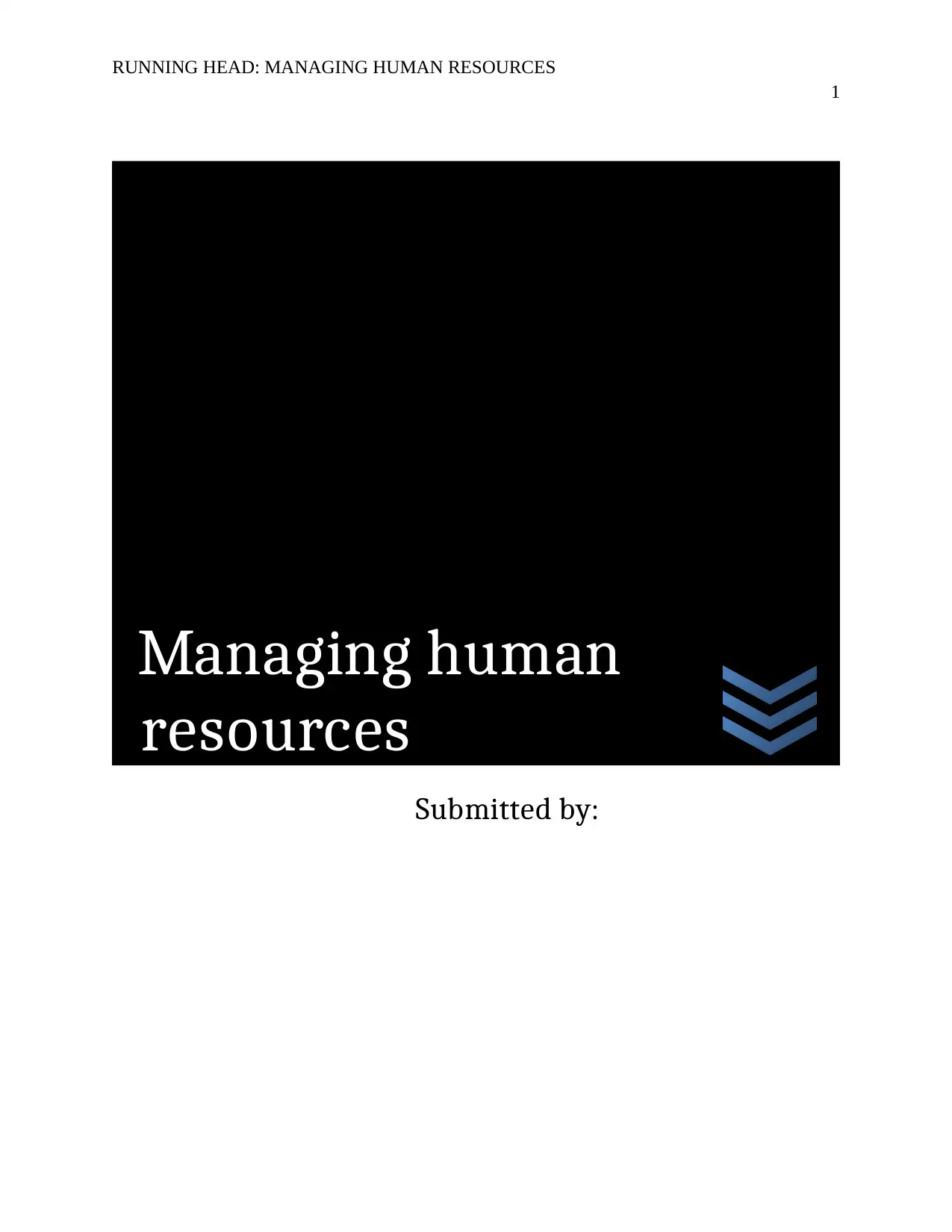
RUNNING HEAD: MANAGING HUMAN RESOURCES
1
Submitted by:
Managing human
resources
1
Submitted by:
Managing human
resources
Paraphrase This Document
Need a fresh take? Get an instant paraphrase of this document with our AI Paraphraser
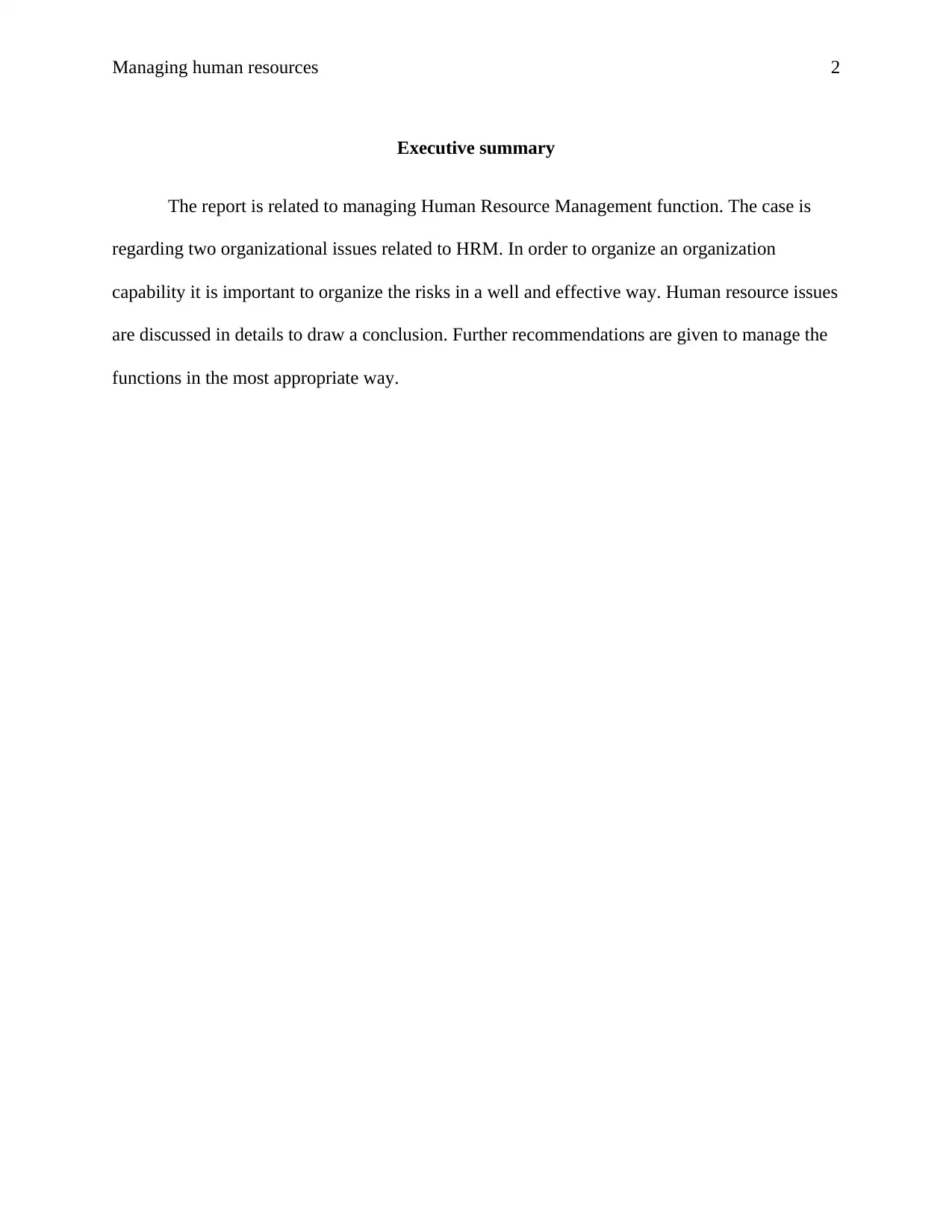
Managing human resources 2
Executive summary
The report is related to managing Human Resource Management function. The case is
regarding two organizational issues related to HRM. In order to organize an organization
capability it is important to organize the risks in a well and effective way. Human resource issues
are discussed in details to draw a conclusion. Further recommendations are given to manage the
functions in the most appropriate way.
Executive summary
The report is related to managing Human Resource Management function. The case is
regarding two organizational issues related to HRM. In order to organize an organization
capability it is important to organize the risks in a well and effective way. Human resource issues
are discussed in details to draw a conclusion. Further recommendations are given to manage the
functions in the most appropriate way.
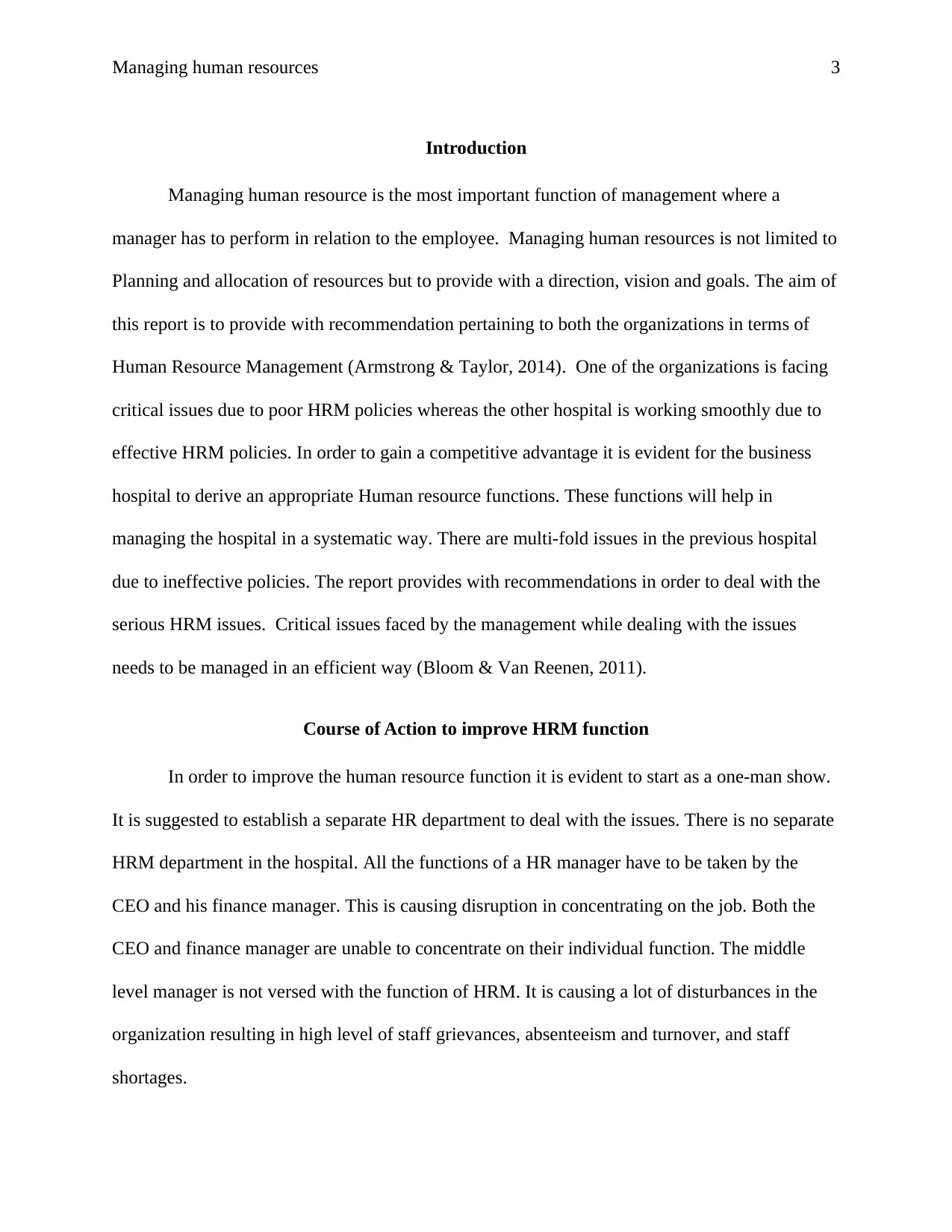
Managing human resources 3
Introduction
Managing human resource is the most important function of management where a
manager has to perform in relation to the employee. Managing human resources is not limited to
Planning and allocation of resources but to provide with a direction, vision and goals. The aim of
this report is to provide with recommendation pertaining to both the organizations in terms of
Human Resource Management (Armstrong & Taylor, 2014). One of the organizations is facing
critical issues due to poor HRM policies whereas the other hospital is working smoothly due to
effective HRM policies. In order to gain a competitive advantage it is evident for the business
hospital to derive an appropriate Human resource functions. These functions will help in
managing the hospital in a systematic way. There are multi-fold issues in the previous hospital
due to ineffective policies. The report provides with recommendations in order to deal with the
serious HRM issues. Critical issues faced by the management while dealing with the issues
needs to be managed in an efficient way (Bloom & Van Reenen, 2011).
Course of Action to improve HRM function
In order to improve the human resource function it is evident to start as a one-man show.
It is suggested to establish a separate HR department to deal with the issues. There is no separate
HRM department in the hospital. All the functions of a HR manager have to be taken by the
CEO and his finance manager. This is causing disruption in concentrating on the job. Both the
CEO and finance manager are unable to concentrate on their individual function. The middle
level manager is not versed with the function of HRM. It is causing a lot of disturbances in the
organization resulting in high level of staff grievances, absenteeism and turnover, and staff
shortages.
Introduction
Managing human resource is the most important function of management where a
manager has to perform in relation to the employee. Managing human resources is not limited to
Planning and allocation of resources but to provide with a direction, vision and goals. The aim of
this report is to provide with recommendation pertaining to both the organizations in terms of
Human Resource Management (Armstrong & Taylor, 2014). One of the organizations is facing
critical issues due to poor HRM policies whereas the other hospital is working smoothly due to
effective HRM policies. In order to gain a competitive advantage it is evident for the business
hospital to derive an appropriate Human resource functions. These functions will help in
managing the hospital in a systematic way. There are multi-fold issues in the previous hospital
due to ineffective policies. The report provides with recommendations in order to deal with the
serious HRM issues. Critical issues faced by the management while dealing with the issues
needs to be managed in an efficient way (Bloom & Van Reenen, 2011).
Course of Action to improve HRM function
In order to improve the human resource function it is evident to start as a one-man show.
It is suggested to establish a separate HR department to deal with the issues. There is no separate
HRM department in the hospital. All the functions of a HR manager have to be taken by the
CEO and his finance manager. This is causing disruption in concentrating on the job. Both the
CEO and finance manager are unable to concentrate on their individual function. The middle
level manager is not versed with the function of HRM. It is causing a lot of disturbances in the
organization resulting in high level of staff grievances, absenteeism and turnover, and staff
shortages.
⊘ This is a preview!⊘
Do you want full access?
Subscribe today to unlock all pages.

Trusted by 1+ million students worldwide
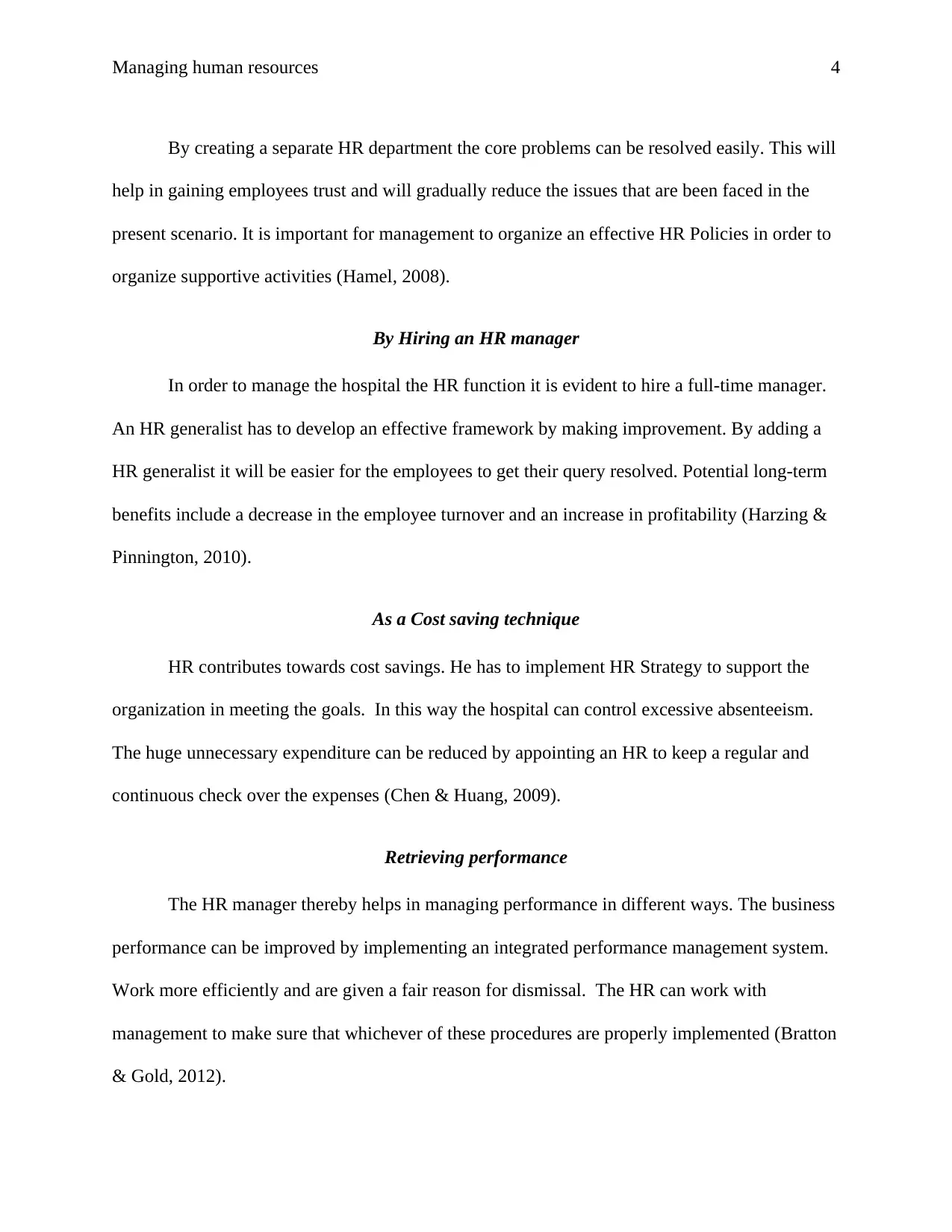
Managing human resources 4
By creating a separate HR department the core problems can be resolved easily. This will
help in gaining employees trust and will gradually reduce the issues that are been faced in the
present scenario. It is important for management to organize an effective HR Policies in order to
organize supportive activities (Hamel, 2008).
By Hiring an HR manager
In order to manage the hospital the HR function it is evident to hire a full-time manager.
An HR generalist has to develop an effective framework by making improvement. By adding a
HR generalist it will be easier for the employees to get their query resolved. Potential long-term
benefits include a decrease in the employee turnover and an increase in profitability (Harzing &
Pinnington, 2010).
As a Cost saving technique
HR contributes towards cost savings. He has to implement HR Strategy to support the
organization in meeting the goals. In this way the hospital can control excessive absenteeism.
The huge unnecessary expenditure can be reduced by appointing an HR to keep a regular and
continuous check over the expenses (Chen & Huang, 2009).
Retrieving performance
The HR manager thereby helps in managing performance in different ways. The business
performance can be improved by implementing an integrated performance management system.
Work more efficiently and are given a fair reason for dismissal. The HR can work with
management to make sure that whichever of these procedures are properly implemented (Bratton
& Gold, 2012).
By creating a separate HR department the core problems can be resolved easily. This will
help in gaining employees trust and will gradually reduce the issues that are been faced in the
present scenario. It is important for management to organize an effective HR Policies in order to
organize supportive activities (Hamel, 2008).
By Hiring an HR manager
In order to manage the hospital the HR function it is evident to hire a full-time manager.
An HR generalist has to develop an effective framework by making improvement. By adding a
HR generalist it will be easier for the employees to get their query resolved. Potential long-term
benefits include a decrease in the employee turnover and an increase in profitability (Harzing &
Pinnington, 2010).
As a Cost saving technique
HR contributes towards cost savings. He has to implement HR Strategy to support the
organization in meeting the goals. In this way the hospital can control excessive absenteeism.
The huge unnecessary expenditure can be reduced by appointing an HR to keep a regular and
continuous check over the expenses (Chen & Huang, 2009).
Retrieving performance
The HR manager thereby helps in managing performance in different ways. The business
performance can be improved by implementing an integrated performance management system.
Work more efficiently and are given a fair reason for dismissal. The HR can work with
management to make sure that whichever of these procedures are properly implemented (Bratton
& Gold, 2012).
Paraphrase This Document
Need a fresh take? Get an instant paraphrase of this document with our AI Paraphraser
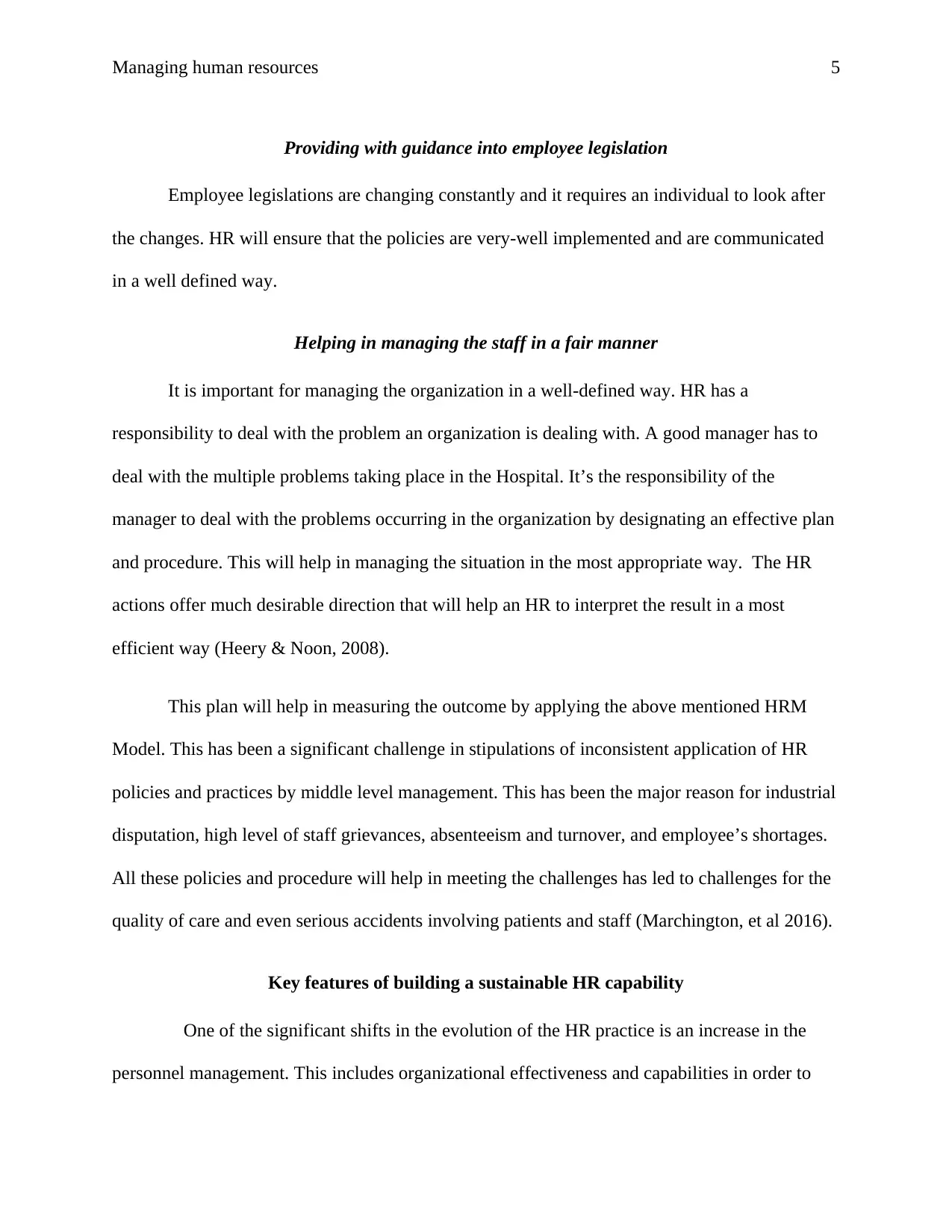
Managing human resources 5
Providing with guidance into employee legislation
Employee legislations are changing constantly and it requires an individual to look after
the changes. HR will ensure that the policies are very-well implemented and are communicated
in a well defined way.
Helping in managing the staff in a fair manner
It is important for managing the organization in a well-defined way. HR has a
responsibility to deal with the problem an organization is dealing with. A good manager has to
deal with the multiple problems taking place in the Hospital. It’s the responsibility of the
manager to deal with the problems occurring in the organization by designating an effective plan
and procedure. This will help in managing the situation in the most appropriate way. The HR
actions offer much desirable direction that will help an HR to interpret the result in a most
efficient way (Heery & Noon, 2008).
This plan will help in measuring the outcome by applying the above mentioned HRM
Model. This has been a significant challenge in stipulations of inconsistent application of HR
policies and practices by middle level management. This has been the major reason for industrial
disputation, high level of staff grievances, absenteeism and turnover, and employee’s shortages.
All these policies and procedure will help in meeting the challenges has led to challenges for the
quality of care and even serious accidents involving patients and staff (Marchington, et al 2016).
Key features of building a sustainable HR capability
One of the significant shifts in the evolution of the HR practice is an increase in the
personnel management. This includes organizational effectiveness and capabilities in order to
Providing with guidance into employee legislation
Employee legislations are changing constantly and it requires an individual to look after
the changes. HR will ensure that the policies are very-well implemented and are communicated
in a well defined way.
Helping in managing the staff in a fair manner
It is important for managing the organization in a well-defined way. HR has a
responsibility to deal with the problem an organization is dealing with. A good manager has to
deal with the multiple problems taking place in the Hospital. It’s the responsibility of the
manager to deal with the problems occurring in the organization by designating an effective plan
and procedure. This will help in managing the situation in the most appropriate way. The HR
actions offer much desirable direction that will help an HR to interpret the result in a most
efficient way (Heery & Noon, 2008).
This plan will help in measuring the outcome by applying the above mentioned HRM
Model. This has been a significant challenge in stipulations of inconsistent application of HR
policies and practices by middle level management. This has been the major reason for industrial
disputation, high level of staff grievances, absenteeism and turnover, and employee’s shortages.
All these policies and procedure will help in meeting the challenges has led to challenges for the
quality of care and even serious accidents involving patients and staff (Marchington, et al 2016).
Key features of building a sustainable HR capability
One of the significant shifts in the evolution of the HR practice is an increase in the
personnel management. This includes organizational effectiveness and capabilities in order to
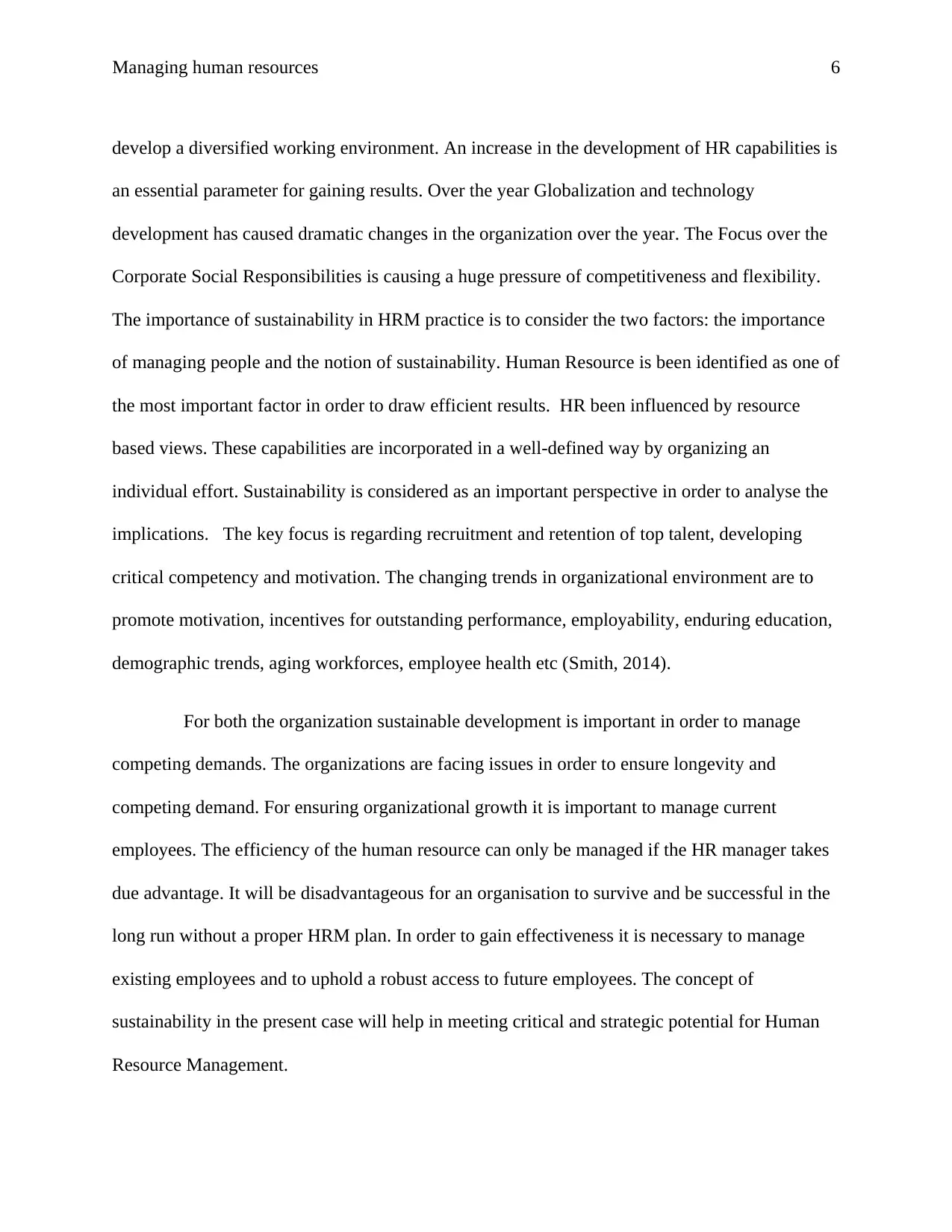
Managing human resources 6
develop a diversified working environment. An increase in the development of HR capabilities is
an essential parameter for gaining results. Over the year Globalization and technology
development has caused dramatic changes in the organization over the year. The Focus over the
Corporate Social Responsibilities is causing a huge pressure of competitiveness and flexibility.
The importance of sustainability in HRM practice is to consider the two factors: the importance
of managing people and the notion of sustainability. Human Resource is been identified as one of
the most important factor in order to draw efficient results. HR been influenced by resource
based views. These capabilities are incorporated in a well-defined way by organizing an
individual effort. Sustainability is considered as an important perspective in order to analyse the
implications. The key focus is regarding recruitment and retention of top talent, developing
critical competency and motivation. The changing trends in organizational environment are to
promote motivation, incentives for outstanding performance, employability, enduring education,
demographic trends, aging workforces, employee health etc (Smith, 2014).
For both the organization sustainable development is important in order to manage
competing demands. The organizations are facing issues in order to ensure longevity and
competing demand. For ensuring organizational growth it is important to manage current
employees. The efficiency of the human resource can only be managed if the HR manager takes
due advantage. It will be disadvantageous for an organisation to survive and be successful in the
long run without a proper HRM plan. In order to gain effectiveness it is necessary to manage
existing employees and to uphold a robust access to future employees. The concept of
sustainability in the present case will help in meeting critical and strategic potential for Human
Resource Management.
develop a diversified working environment. An increase in the development of HR capabilities is
an essential parameter for gaining results. Over the year Globalization and technology
development has caused dramatic changes in the organization over the year. The Focus over the
Corporate Social Responsibilities is causing a huge pressure of competitiveness and flexibility.
The importance of sustainability in HRM practice is to consider the two factors: the importance
of managing people and the notion of sustainability. Human Resource is been identified as one of
the most important factor in order to draw efficient results. HR been influenced by resource
based views. These capabilities are incorporated in a well-defined way by organizing an
individual effort. Sustainability is considered as an important perspective in order to analyse the
implications. The key focus is regarding recruitment and retention of top talent, developing
critical competency and motivation. The changing trends in organizational environment are to
promote motivation, incentives for outstanding performance, employability, enduring education,
demographic trends, aging workforces, employee health etc (Smith, 2014).
For both the organization sustainable development is important in order to manage
competing demands. The organizations are facing issues in order to ensure longevity and
competing demand. For ensuring organizational growth it is important to manage current
employees. The efficiency of the human resource can only be managed if the HR manager takes
due advantage. It will be disadvantageous for an organisation to survive and be successful in the
long run without a proper HRM plan. In order to gain effectiveness it is necessary to manage
existing employees and to uphold a robust access to future employees. The concept of
sustainability in the present case will help in meeting critical and strategic potential for Human
Resource Management.
⊘ This is a preview!⊘
Do you want full access?
Subscribe today to unlock all pages.

Trusted by 1+ million students worldwide
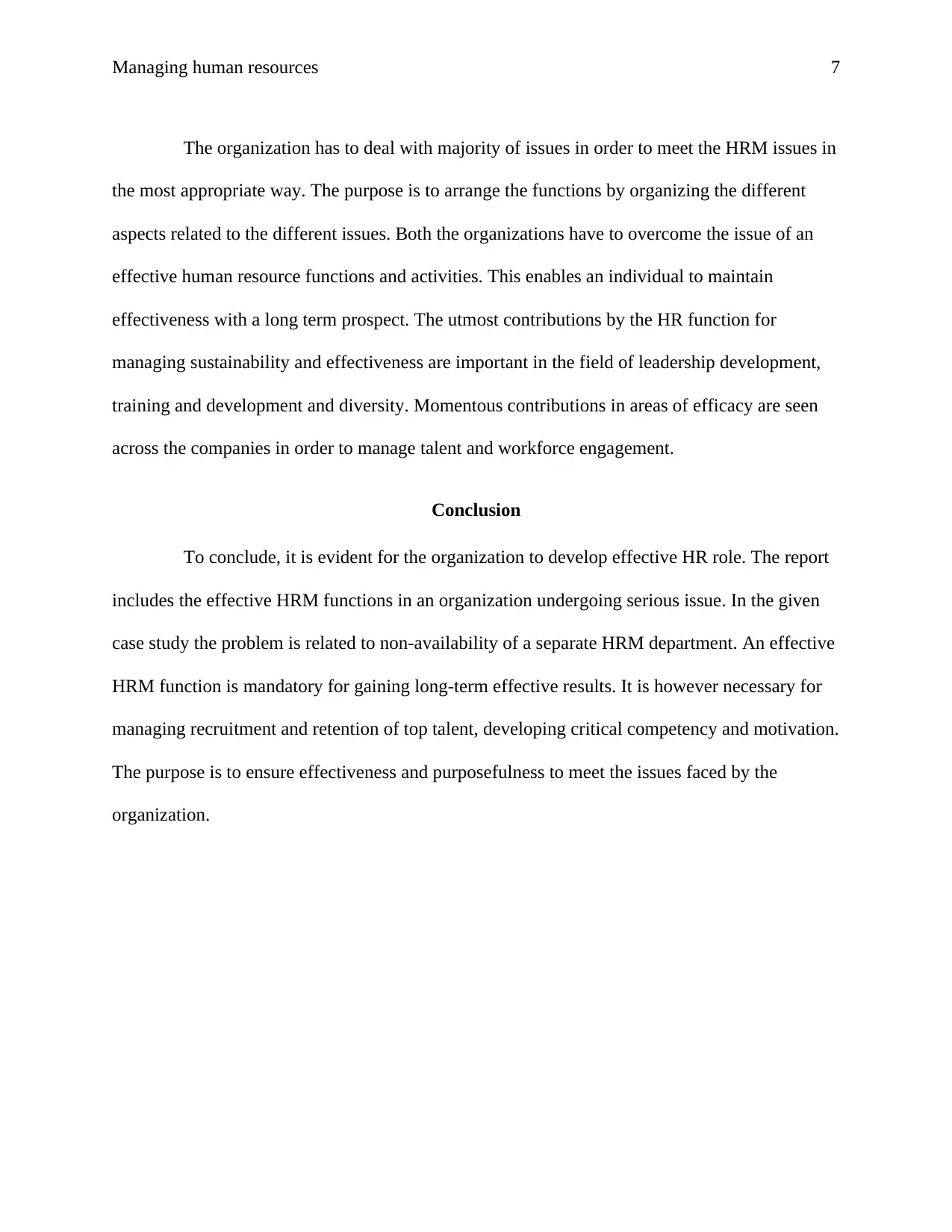
Managing human resources 7
The organization has to deal with majority of issues in order to meet the HRM issues in
the most appropriate way. The purpose is to arrange the functions by organizing the different
aspects related to the different issues. Both the organizations have to overcome the issue of an
effective human resource functions and activities. This enables an individual to maintain
effectiveness with a long term prospect. The utmost contributions by the HR function for
managing sustainability and effectiveness are important in the field of leadership development,
training and development and diversity. Momentous contributions in areas of efficacy are seen
across the companies in order to manage talent and workforce engagement.
Conclusion
To conclude, it is evident for the organization to develop effective HR role. The report
includes the effective HRM functions in an organization undergoing serious issue. In the given
case study the problem is related to non-availability of a separate HRM department. An effective
HRM function is mandatory for gaining long-term effective results. It is however necessary for
managing recruitment and retention of top talent, developing critical competency and motivation.
The purpose is to ensure effectiveness and purposefulness to meet the issues faced by the
organization.
The organization has to deal with majority of issues in order to meet the HRM issues in
the most appropriate way. The purpose is to arrange the functions by organizing the different
aspects related to the different issues. Both the organizations have to overcome the issue of an
effective human resource functions and activities. This enables an individual to maintain
effectiveness with a long term prospect. The utmost contributions by the HR function for
managing sustainability and effectiveness are important in the field of leadership development,
training and development and diversity. Momentous contributions in areas of efficacy are seen
across the companies in order to manage talent and workforce engagement.
Conclusion
To conclude, it is evident for the organization to develop effective HR role. The report
includes the effective HRM functions in an organization undergoing serious issue. In the given
case study the problem is related to non-availability of a separate HRM department. An effective
HRM function is mandatory for gaining long-term effective results. It is however necessary for
managing recruitment and retention of top talent, developing critical competency and motivation.
The purpose is to ensure effectiveness and purposefulness to meet the issues faced by the
organization.
Paraphrase This Document
Need a fresh take? Get an instant paraphrase of this document with our AI Paraphraser
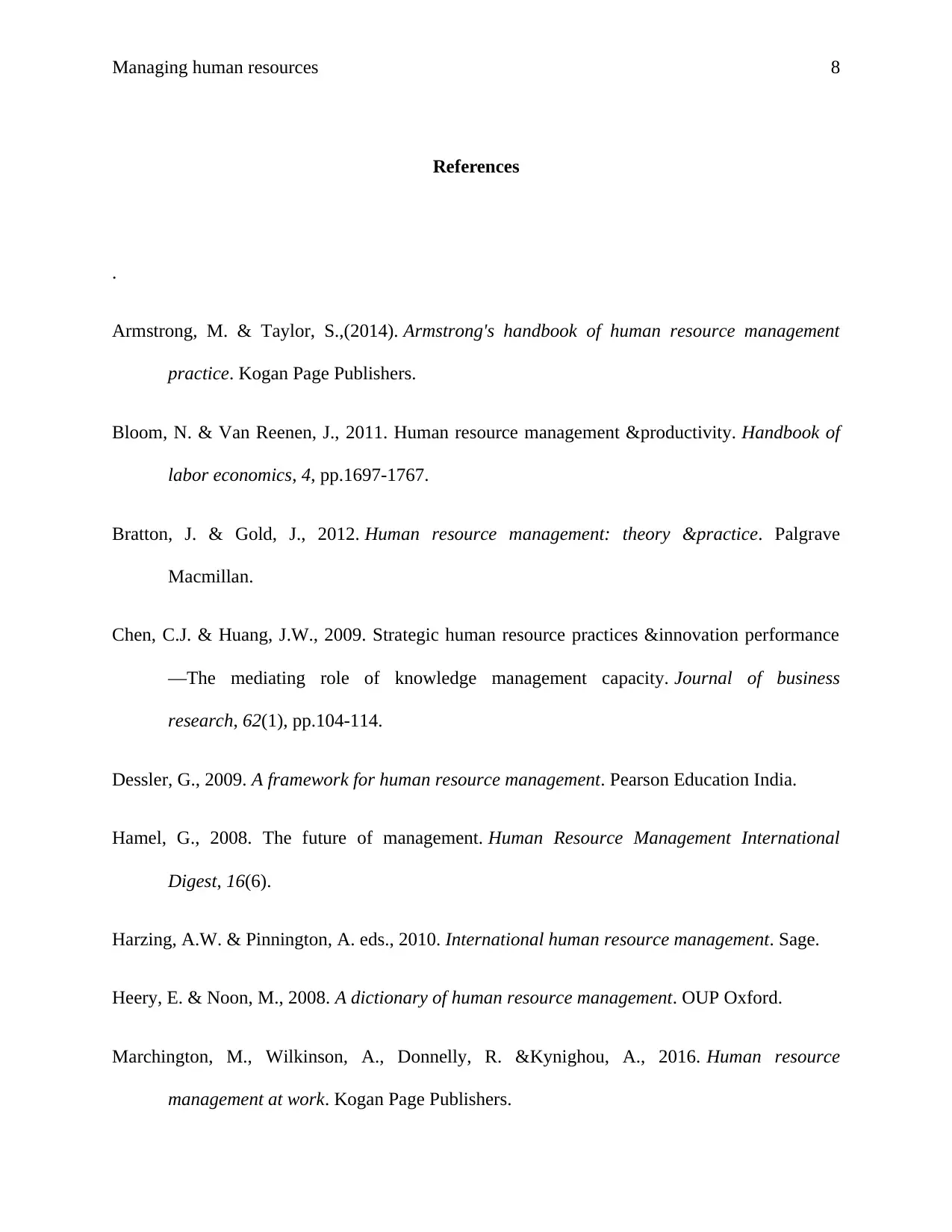
Managing human resources 8
References
.
Armstrong, M. & Taylor, S.,(2014). Armstrong's handbook of human resource management
practice. Kogan Page Publishers.
Bloom, N. & Van Reenen, J., 2011. Human resource management &productivity. Handbook of
labor economics, 4, pp.1697-1767.
Bratton, J. & Gold, J., 2012. Human resource management: theory &practice. Palgrave
Macmillan.
Chen, C.J. & Huang, J.W., 2009. Strategic human resource practices &innovation performance
—The mediating role of knowledge management capacity. Journal of business
research, 62(1), pp.104-114.
Dessler, G., 2009. A framework for human resource management. Pearson Education India.
Hamel, G., 2008. The future of management. Human Resource Management International
Digest, 16(6).
Harzing, A.W. & Pinnington, A. eds., 2010. International human resource management. Sage.
Heery, E. & Noon, M., 2008. A dictionary of human resource management. OUP Oxford.
Marchington, M., Wilkinson, A., Donnelly, R. &Kynighou, A., 2016. Human resource
management at work. Kogan Page Publishers.
References
.
Armstrong, M. & Taylor, S.,(2014). Armstrong's handbook of human resource management
practice. Kogan Page Publishers.
Bloom, N. & Van Reenen, J., 2011. Human resource management &productivity. Handbook of
labor economics, 4, pp.1697-1767.
Bratton, J. & Gold, J., 2012. Human resource management: theory &practice. Palgrave
Macmillan.
Chen, C.J. & Huang, J.W., 2009. Strategic human resource practices &innovation performance
—The mediating role of knowledge management capacity. Journal of business
research, 62(1), pp.104-114.
Dessler, G., 2009. A framework for human resource management. Pearson Education India.
Hamel, G., 2008. The future of management. Human Resource Management International
Digest, 16(6).
Harzing, A.W. & Pinnington, A. eds., 2010. International human resource management. Sage.
Heery, E. & Noon, M., 2008. A dictionary of human resource management. OUP Oxford.
Marchington, M., Wilkinson, A., Donnelly, R. &Kynighou, A., 2016. Human resource
management at work. Kogan Page Publishers.
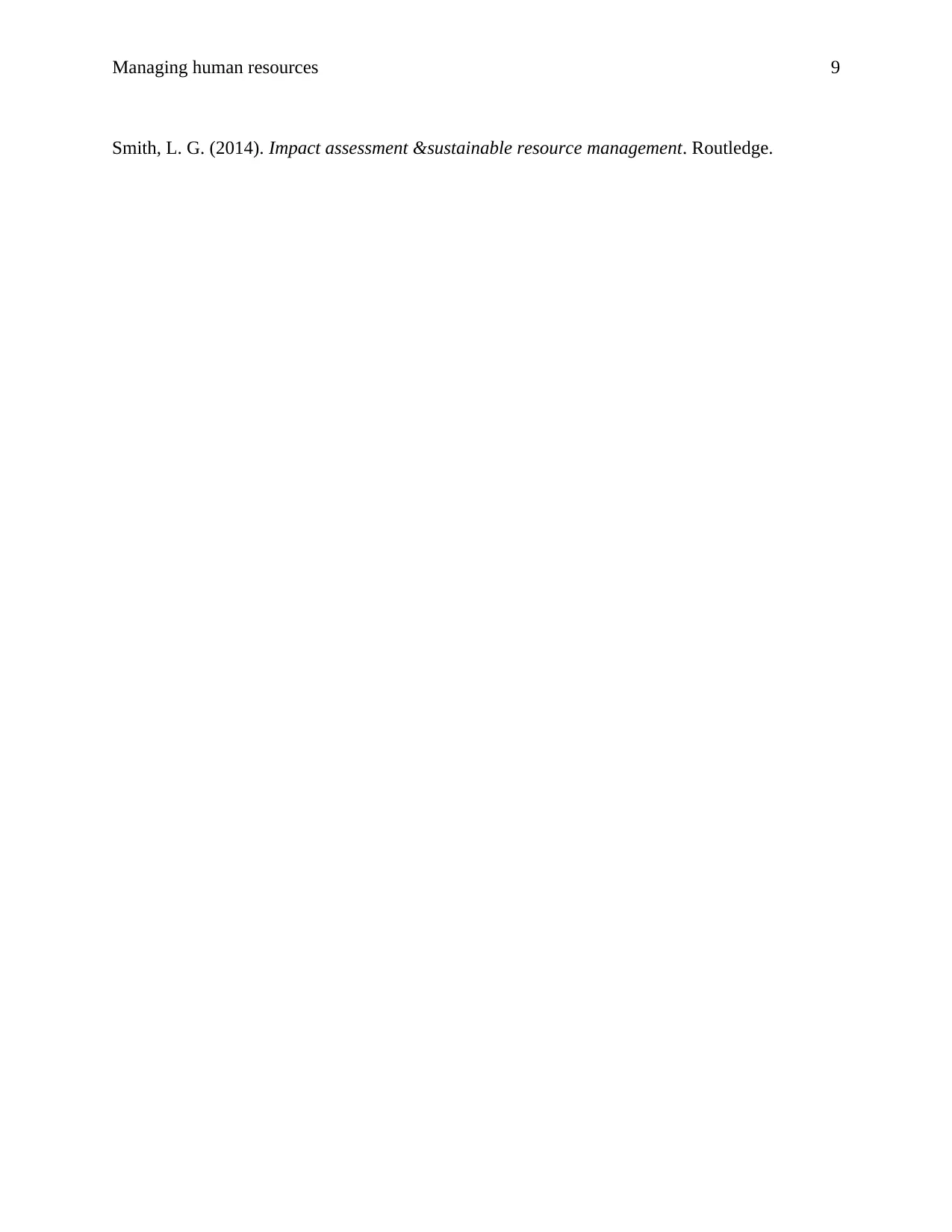
Managing human resources 9
Smith, L. G. (2014). Impact assessment &sustainable resource management. Routledge.
Smith, L. G. (2014). Impact assessment &sustainable resource management. Routledge.
⊘ This is a preview!⊘
Do you want full access?
Subscribe today to unlock all pages.

Trusted by 1+ million students worldwide
1 out of 9
Related Documents
Your All-in-One AI-Powered Toolkit for Academic Success.
+13062052269
info@desklib.com
Available 24*7 on WhatsApp / Email
![[object Object]](/_next/static/media/star-bottom.7253800d.svg)
Unlock your academic potential
Copyright © 2020–2025 A2Z Services. All Rights Reserved. Developed and managed by ZUCOL.





